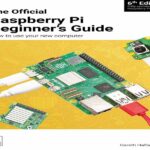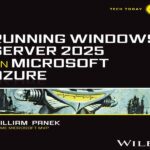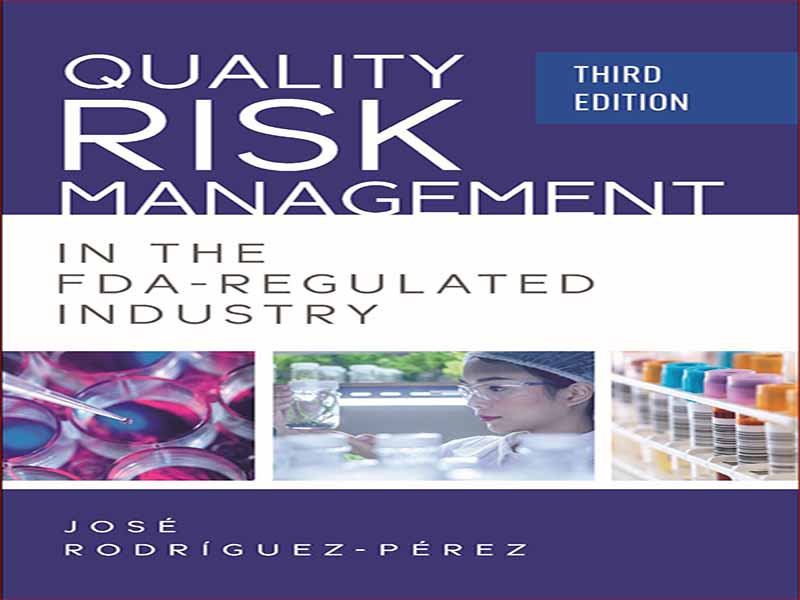- عنوان کتاب: Quality Risk Management in the FDA-Regulated Industry
- نویسنده/انتشارات: José Rodríguez-Pérez
- حوزه: مدیریت مخاطرات
- سال انتشار: 2024
- تعداد صفحه: 313
- زبان اصلی: انگلیسی
- نوع فایل: pdf
- حجم فایل: 9.55 مگابایت
از زمان انتشار اولین ویرایش این کتاب در سال 2012، تاکید بر فرآیندهای مبتنی بر ریسک به طور تصاعدی در همه بخشها افزایش یافته است و مدیریت ریسک در حال حاضر به اندازه مدیریت کیفیت قابل توجه است. ISO 9001، استاندارد بین المللی اساسی سیستم مدیریت کیفیت (QMS)، اخیراً تحت نسخه جدید ISO 9001:2015 (سازمان بین المللی استاندارد 2015) بازنگری شد و اکنون مستلزم آن است که مدیریت ارشد استفاده از تفکر مبتنی بر ریسک را ترویج دهد. نمونه دیگری از تاکید بیشتر بر مدیریت ریسک، استاندارد بین المللی ISO 13485:2016 است که الزامات یک QMS را مختص صنعت تجهیزات پزشکی مشخص می کند. نسخه جدید منتشر شده در مارس 2016 (سازمان بین المللی استاندارد 2016) تاکید بیشتری بر مدیریت ریسک و تصمیم گیری مبتنی بر ریسک نشان می دهد. مثال سوم ایالات متحده است. FDA Food Safety Modernization Act (FSMA)، مهمترین اصلاحات ایالات متحده قوانین ایمنی مواد غذایی در بیش از 70 سال این قانون در 4 ژانویه 2011 توسط پرزیدنت اوباما امضا شد. هدف آن تضمین این است که ایالات متحده عرضه غذا با تغییر تمرکز از پاسخ به آلودگی به جلوگیری از آن ایمن است. به عبارت دیگر، این یک سیستم پیشگیری از ایمنی مواد غذایی مبتنی بر ریسک است. هدف این ویرایش سوم این کتاب ارائه دیدگاهی به روز از حوزه مدیریت ریسک است که در مورد محصولات تحت نظارت FDA اعمال می شود. سه دستورالعمل کلیدی اخیراً بهروزرسانی شدهاند [ICH Q9(R1)، ISO 14971:2019، و ISO 22000:2018]، و در این ویرایش جدید مورد بحث قرار گرفتهاند. این کتاب با ارائه توضیحات و مثالهای عملی به تولیدکنندگان محصولات پزشکی و غذایی کمک میکند تا یک سیستم مدیریت ریسک یا اصول و فعالیتهای مدیریت ریسک را در QMS موجود خود ادغام کنند. استفاده مناسب از مدیریت ریسک کیفیت می تواند انطباق با الزامات نظارتی مانند عملکرد خوب تولید یا عملکرد خوب آزمایشگاهی را تسهیل کند. فصل اول کتاب پیشینه تاریخی مفاهیم مبتنی بر ریسک و اینکه چگونه تمرکز اولیه فقط ایمنی به یک سناریوی گسترده تر با در نظر گرفتن چندین عنصر دیگر منتقل شد را ارائه می دهد. فصل دوم آنچه را که در حال حاضر در زمینه های مختلف تنظیم شده توسط FDA انجام می شود، ارائه می دهد. اسناد هماهنگ سازی به روز شده و استانداردهای بین المللی توسعه یافته برای انواع مختلف محصولات مانند دستگاه های پزشکی، مواد غذایی و داروها را شرح می دهد. این فصل اکنون شامل الزامات خطر جدیدترین نسخه ISO 14971:2019 برای دستگاه های پزشکی، دستورالعمل به روز شده ICH برای صنعت Q9(R1) منتشر شده در می 2023 و نسخه جدید ISO 22000:2018 با الزامات به روز شده آن برای مواد غذایی است. سیستم های مدیریت ایمنی بخش جدیدی برای بحث در مورد آخرین ابتکار اجرا شده توسط FDA برای استفاده از برنامه های مدیریت ریسک برای کاهش پتانسیل کمبود دارو گنجانده شد. فصل سوم اصول اصلی حوزه مدیریت ریسک کیفیت را تشریح می کند، بر مبنای علمی صحیح فرآیند مدیریت ریسک کیفیت و ارتباط نزدیک آن با عناصر سیستم کیفیت تاکید می کند. فصل چهارم جزئیات فرآیند مدیریت ریسک کیفیت، تعریف مسئولیت ها و سپس، به ترتیب، کل فرآیند، شروع با ارزیابی ریسک، ادامه با کنترل ریسک و ارتباطات ریسک و پایان یافتن با بررسی و ارزیابی اثربخشی فرآیند ریسک است. فصل پنجم ادغام بین مدیریت ریسک و مدیریت کیفیت، از جمله مثالهای مفصلی از این ادغام را توضیح میدهد. همچنین شامل بخشی بود که خطرات قبل و پس از فروش محصولات پزشکی را پوشش می داد. فصل ششم مجموعهای از روشها و ابزارهایی را که به طور گسترده در فرآیندهای مدیریت ریسک استفاده میشوند، ارائه میکند. هر ابزار با جزئیات کامل توضیح داده شده است، از جمله نمونه های واقعی از صنعت تحت نظارت FDA. این مثالها این را به یکی از با ارزشترین بخشهای این کتاب تبدیل میکند، همراه با توضیحات بسیار دقیق و مثالهایی از کاربردهای عملی که در فصل 7 یافت میشوند، از جمله موضوعاتی مانند کاهش خطر خطا، تعیین سود-ریسک، و مسائل مربوط به یکپارچگی دادهها. . فصل هشتم برخی از رایجترین دامها و سوء تفاهمها در مورد مدیریت ریسک، بهویژه موارد مربوط به استفاده از حالت شکست و تحلیل اثرات (FMEA) به عنوان تنها عنصر برنامههای مدیریت ریسک را مورد بحث قرار میدهد.
Since the publication of the first edition of this book in 2012, the emphasis on risk-based processes has grown exponentially across all sectors, and risk management is now considered as significant as quality management. ISO 9001, the fundamental international quality management system (QMS) standard, was recently revised under the new version, ISO 9001:2015 (International Organization for Standardization 2015), and it now requires that top management promote the use of riskbased thinking. Another example of the greater emphasis on risk management is the international standard ISO 13485:2016, which specifies the requirements for a QMS specific to the medical device industry. The new version published in March 2016 (International Organization for Standardization 2016) shows a greater emphasis on risk management and risk-based decision-making. A third example is the U.S. FDA Food Safety Modernization Act (FSMA), the most important reform of U.S. food safety laws in more than 70 years. It was signed into law by President Obama on January 4, 2011. It aims to ensure that the U.S. food supply is safe by shifting the focus from responding to contamination to preventing it. In other words, it is a riskbased food safety prevention system. The purpose of this third edition of this book is to offer an updated view of the risk management field as it applies to FDA-regulated products. Three key guidelines have been recently updated [ICH Q9(R1), ISO 14971:2019, and ISO 22000:2018], and they are discussed in this new edition. This book will assist medical and food product manufacturers with the integration of a risk management system or risk management principles and activities into their existing QMS by providing practical explanations and examples. The appropriate use of quality risk management can facilitate compliance with regulatory requirements such as good manufacturing practice or good laboratory practice. The first chapter of the book presents the historical background of the risk-based concepts and how the initial safety-only focus moved to a wider scenario with the consideration of several other elements. The second chapter presents what is currently being done in the different areas regulated by the FDA. It describes the updated harmonization documents and international standards developed for different types of products such as medical devices, food, and drugs. This chapter now includes the risk requirement of the newest version of ISO 14971:2019 for medical devices, the updated ICH guidance for industry Q9(R1) published in May 2023, and the new version of ISO 22000:2018 with its updated requirements for food safety management systems. A new section was included to discuss the latest initiative implemented by the FDA to use risk management plans to mitigate the potential of drug shortages. The third chapter describes the main principles of the quality risk management field, emphasizing the sound scientific basis of the quality risk management process and its close relationship with quality system elements. The fourth chapter details the quality risk management process, defining responsibilities and then, sequentially, the whole process, starting with risk assessment, continuing with risk control and risk communication, and ending with a review and evaluation of the effectiveness of the risk process. The fifth chapter describes the integration between risk management and quality management, including detailed examples of such integration. It also included a section covering pre- and post-market risk for medical products. The sixth chapter presents a collection of the methodologies and tools more widely used during risk management processes. Each tool is explained in great detail, including real examples from the FDA-regulated industry. These examples make this one of the most valuable sections of this book, along with the very detailed explanation and examples of practical applications that can be found in Chapter 7, including topics such as error risk reduction, benefit–risk determination, and data integrity issues. The eighth chapter discusses some of the most common pitfalls and misunderstandings regarding risk management, specifically those related to the use of failure mode and effects analysis (FMEA) as the only element of risk management programs.
این کتاب را میتوانید از لینک زیر بصورت رایگان دانلود کنید:
Download: Quality Risk Management in the FDA-Regulated Industry




































نظرات کاربران